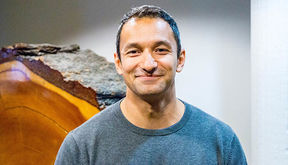Seven-figure grant for researcher producing carbon fibre from wood

Michael Hummel, Postdoctoral Researcher at Aalto University, has been awarded the ca. 1.5 million euro Starting Grant by the European Research Council (ERC). The funding was granted for a five-year project aiming at the manufacture of high-quality carbon fibres from wood.
Carbon fibres and composites made thereof are extremely strong and lightweight materials with many applications, such as replacing heavy structural parts in airplanes and space crafts. So far, the high price of carbon fibres has prevented more wide-spread use.
‘For example, the car industry is interested in producing weight-reduced and, consequently, more energy-efficient vehicles, but traditional carbon fibres manufactured from the synthetic polymer PAN (polyacrylonitrile) are still too expensive. So far efforts to replace PAN were focused on either cellulose or lignin in isolated form as precursors for carbon fibres. This has yet not resulted in fibres attractive for industrial applications. With the technology in our hands we can produce hybrid fibres composed of both components– cellulose and lignin – as the precursor material for carbon fibre. It is not only cheaper but also more ecological, since the manufacturing process consumes less energy and chemicals and the raw material is renewable instead of an oil-based feedstocks’, explains Hummel.
‘We expect synergistic effects of the two polymers. Our goal of 2 GPa tensile strength and 200 GPa modulus of elasticity is lower than in PAN-based carbon fibre, but would suit the needs of the car industry and sports equipment manufacturers.’
Unique spinning method
The hybrid fibre is manufactured using the Ioncell-F spinning technology developed by Aalto University Professor Herbert Sixta’s research group. The method has previously been used to produce high-quality textile fibre from pulp cellulose and recycled materials. Ioncell-F is based on the dissolution of biomass in a non-toxic solvent developed by University of Helsinki Professor Ilkka Kilpeläinen, followed by the extrusion of the solution through spinnerets to produce endless filaments.
‘When we started working on the Ioncell process, we did not yet anticipate the potential of the solvent. In the beginning of the ERC project, we will blend cellulose and lignin within the hybrid fibre, to understand the interplay of the two polymers. But as we progress, the goal is to use the entire wood matrix almost in its native form, which will further reduce the environmental impact and total energy necessary to produce carbon fibres’, tells Michael Hummel.
After spinning, the fibres are transferred to furnaces where they are slowly heated up to 1500 degrees Celsius – this is called the carbonization. What remains is pure carbon which forms an extremely durable chemical structure.
‘We are cooperating with Deakin University in Australia within this project. They have several carbonization lines of different sizes and are well tied to relevant industrial partners, which helps us to get immediate feedback on the potential of wood-based carbon fibre.’
More information:
Postdoctoral Researcher Michael Hummel
Tel. +358 50 512 4198
[email protected]
- Published:
- Updated:
Read more news

Get to know us: Associate Professor Maria Sammalkorpi
Sammalkorpi received her doctorate from Helsinki University of Technology 2004. After her defence, she has worked as a researcher at the Universities of Princeton, Yale and Aalto.
Aalto computer scientists in ICML 2024
Computer scientists in ICML 2024
In low-hierarchy organisations, even key policy issues are discussed in Slack
In a recent study, Aalto University alumn Lauri Pietinalho, a visiting scholar at New York University's Stern School of Business, and Frank Martela, an assistant professor at Aalto University, investigated how low-hierarchy organisations deal with shared policies in confrontational situations and how authority functions within them.